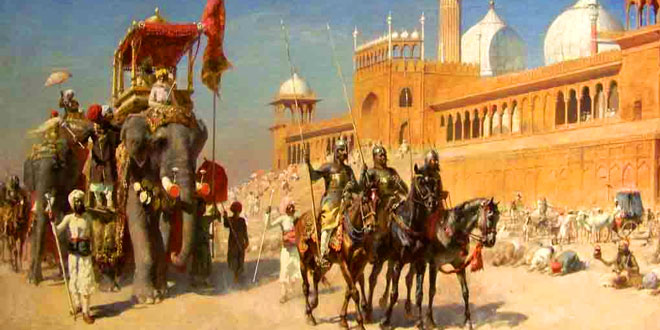Question: Write an essay on the Rashtrakuta dynasty outlining how they built their empire.
New Kings and Kingdoms – Answer: Rashtrakuta Dynasty:
- The Rashtrakutas ruled over large parts of southern, central and northern India between the 8th and 10th Centuries CE.
- The Rashtrakutas came to power under the leadership of Dantidurga, who defeated the Chalukyas of Badami in 753 CE and the Gurjaras of Malwa.
- He then went on to capture Kalinga, Kosala and Srisailam.
- Krishna I succeeded Dantidurga. The rock-cut Kailashnath Temple at Ellora was built during his rule.
- Under Dhruva Dharavarsha (780 CE), the empire expanded further to become a pan-India power. He defeated Palas and Gujara-Pratiharas and annexed Kannauj.
- In the 9th century CE, Amoghavarsha I established his capital at Manyakheta, which remained the capital of the Rashtrakutas till the end of the empire.
- After ruling for over 200 years, the might of the Rashtrakutas was broken by the Chalukyas of Kalyan.
Question: Write a summary of the military victories of Rajaraja Chola and Rajendra Chola. Include a note on their army and navy.
Answer: The Cholas were a powerful ruling dynasty of South India. Credit for glorious Chola rule goes to Rajaraja Chola and his son Rajendra Chola. These two great monarchs gave political unity to South India for the first time.
Rajaraja Chola (985-1014 CE): He followed a policy of war and conquest. He defeated the Eastern Chalukyas of Vengi, the Pandyas, the Gangas of Kalinga and Cheras of Kerela and captured large tracts of the Deccan and even parts of Ceylon.
Rajaraja introduced two important features of the Chola administration-the navy and local self-government. He laid the foundation of powerful Chola navy. In 1005 CE, while he was still a monarch, he appointed his son Rajendra Chola his successor.
Rajendra Chola (1014-1044 CE): He carried Chola power to greater heights. He captured Vengi, sent a naval fleet into the Bay of Bengal and took over parts of Sumatra, Malaya and the Andaman and Nicobar islands. He undertook an expedition to North India around 1023 CE, defeated Mahipala of Pala dynasty, and annexed Bihar, Odisha and Bengal.
Army and Navy: The Cholas developed a powerful army and navy. The army consisted of the infantry, cavalry and elephants. The best horses were imported from Arabia. A huge amount of money was spent for the training and upkeep of the army. The Cholas were first to maintain a large and efficient navy. The Chola navy was one of the strongest aspects of the Chola Empire.
Question: Describe the administrative system that prevailed in the Chola empire.
Answer: Rajaraja built up Chola power with his clever administrative skills. Under him, the Cholas perfected a highly organised administrative system with a strong centre, yet the autonomy of village assemblies was also protected and nurtured.
At the top of the structure was the king, who held all power. The entire kingdom was divided into two categories – areas governed by vassal chiefs and those directly under the king. The part of the kingdom that was directly under the king was divided into six provinces or mandalams. The provinces were divided into districts or nadus, which were further divided into kurams or kottams.
Village administration was carried on by village assemblies called urs. A group or union of villages, called kurams or kottam, managed its affair through sabhas or mahasabhas. The mahasabhas consisted of learned brahmins who were gifted land by the rulers. They had extensive powers. But the sabhas were still under the control of the royal officers, called adhikaris. Elections were held every year by casting votes.
The sabhas had different committees to look after different activities. There were eight committees to deal with various aspects of administration, i.e., gardens, irrigation, cultivation, education, land, roads, judicial and accounts. Each village had a treasury of its own and accounts were maintained carefully.
Question: How did the Rajputs explain their origin?
Answer: Rajputs origin:
- The world ‘Rajputs’ come from the Sanskrit word ‘Rajputra’ which means son of a king. Historians have different opinions regarding their origin.
- Some believe that they were descendants of the central Asian triles settled in India after the Hun invasion.
- The Rajputs however claimed to be descendants of the kshatriyas or warrior class of Vedic Times.
- They claimed that they were ‘Surya-Vanshi’ that is belonging to the sun family or ‘Chandra-Vanshi’ that is belonging to the moon family.
- Some Rajput clans also considered themeselves to be part of the fire family (agni – kula).
Question: How did Muhammad Ghori benefit from Mahmud of Ghazni’s death?
Answer: After Mahmud’s death, however, the Ghaznavids become weak. Taking advantage of this, Muizzudin Muhammad made Ghor independent once again. He also annexed all Ghaznavid territories. Muizzudin Muhammad is popularly known as Muhammad Ghori.
 Class Notes NCERT Solutions for CBSE Students
Class Notes NCERT Solutions for CBSE Students




Please answer the question: A Chola period inscription, carved out of stone, declares that destroyers of the tank will go to the deepest of hell and one who maintains it well will be rewarded with great riches and luxuries in his next birth’. What possible conclusion can you draw from the above statement?
Who helped to perform the ritual Named Hiranya garbha
Are they farmers ‚ bramnas Traders
ITS ALL ABOUT THEIR CULTURE WHICH IS FURTHER DIVIDED AND KNOWN AS SAMANTS
What is meant by tribhuvana chakravartin
Lord of the three worlds.
Who introduced a silver coin called rupiah?